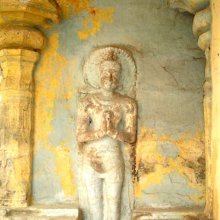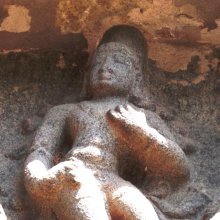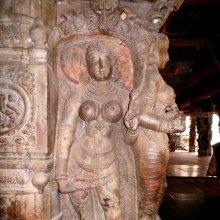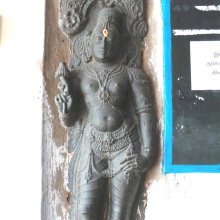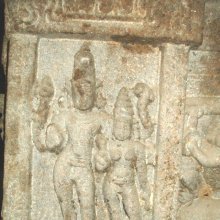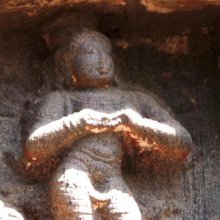Tryashra, Tri-ashra, Tryaśra, Tryasrā: 13 definitions
Introduction:
Tryashra means something in Hinduism, Sanskrit. If you want to know the exact meaning, history, etymology or English translation of this term then check out the descriptions on this page. Add your comment or reference to a book if you want to contribute to this summary article.
The Sanskrit term Tryaśra can be transliterated into English as Tryasra or Tryashra, using the IAST transliteration scheme (?).
Images (photo gallery)
(+20 more images available)
In Hinduism
Natyashastra (theatrics and dramaturgy)
Source: Wisdom Library: Nāṭya-śāstra1) Tryaśra (त्र्यश्र, “triangular”).—One of three main types of playhouses, according to the Nāṭyaśāstra 2.7-8. According to Nāṭyaśāstra 2.101-104, “By the builders, a playhouse (nāṭyamaṇḍapa) with three corners should be built, and the stage in it also should be made triangular. In one corner of the playhouse there should be a door, and a second door should be made at the back of the stage. Rules regarding walls and pillars which hold good in case of a playhouse of the square type (caturaśra), will be applicable in case of the triangular type.”
2) Tryasrā (त्र्यस्रा) refers to a specific gesture (āṅgika) made with the neck (grīvā), according to the Nāṭyaśāstra chapter 8. These ‘gestures of the neck (grīvā)’ should follow the gestures made with the head (śiras). These gestures form a part of the histrionic representation (abhinaya).
Source: archive.org: Natya ShastraTryasrā (त्र्यस्रा).—A type of gesture (āṅgika) made with the neck (grīvā);—Instructions: neck with the face turned sideways. Uses: in carrying weight on the neck, and sorrow.

Natyashastra (नाट्यशास्त्र, nāṭyaśāstra) refers to both the ancient Indian tradition (shastra) of performing arts, (natya—theatrics, drama, dance, music), as well as the name of a Sanskrit work dealing with these subjects. It also teaches the rules for composing Dramatic plays (nataka), construction and performance of Theater, and Poetic works (kavya).
Jyotisha (astronomy and astrology)
Source: Wikibooks (hi): Sanskrit Technical TermsTryasra (त्र्यस्र).—Triangle, more specifically a right-triangle. Note: Tryasra is a Sanskrit technical term used in ancient Indian sciences such as Astronomy, Mathematics and Geometry.

Jyotisha (ज्योतिष, jyotiṣa or jyotish) refers to ‘astronomy’ or “Vedic astrology” and represents the fifth of the six Vedangas (additional sciences to be studied along with the Vedas). Jyotisha concerns itself with the study and prediction of the movements of celestial bodies, in order to calculate the auspicious time for rituals and ceremonies.
Shaktism (Shakta philosophy)
Source: Google Books: ManthanabhairavatantramTryasra (त्र्यस्र) refers to “triangular”, according to the Manthānabhairavatantra, a vast sprawling work that belongs to a corpus of Tantric texts concerned with the worship of the goddess Kubjikā.—Accordingly, “O mother of the universe, it resides within (the Wheel of) the Self-supported above the (Wheel of) the Foundation. (There is) a triangular wheel [i.e., tryasra—tryasraṃ cakraṃ] (there) that is very brilliant and full of radiant rays. In the middle of that is a great Drop whose form is that of a Kadamba flower. That (Wheel) is said to be the Yoni that causes the path of emanation to flow”.

Shakta (शाक्त, śākta) or Shaktism (śāktism) represents a tradition of Hinduism where the Goddess (Devi) is revered and worshipped. Shakta literature includes a range of scriptures, including various Agamas and Tantras, although its roots may be traced back to the Vedas.
Pancaratra (worship of Nārāyaṇa)
Source: Shodhganga: Kasyapa Samhita—Text on Visha Chikitsa (p)Tryaśra (त्र्यश्र) refers to a particular seat mentioned in the meditation on Garuḍa in the Pañcabhūtamaṇḍala, according to the second chapter of the Kāśyapa Saṃhitā: an ancient Sanskrit text from the Pāñcarātra tradition dealing with both Tantra and Viṣacikitsā (Toxicology).—Accordingly, text text dictates that a Garuḍa-upāsaka, the aspirant, must meditate on Garuḍa of the following form—The Kāśyapasaṃhitā describes the different forms of Garuḍa in the five bhūta-maṇḍalas on which the aspirant has to meditate upon to cure the snake-bite victim from the poison which could have killed him. Garuḍa represented as Agni, the lord of fire, is seated in the tryaśra with svastika mark.

Pancaratra (पाञ्चरात्र, pāñcarātra) represents a tradition of Hinduism where Narayana is revered and worshipped. Closeley related to Vaishnavism, the Pancaratra literature includes various Agamas and tantras incorporating many Vaishnava philosophies.
Languages of India and abroad
Sanskrit dictionary
Source: DDSA: The practical Sanskrit-English dictionaryTryaśra (त्र्यश्र).—a. triangular.
-sram a triangle.
Tryaśra is a Sanskrit compound consisting of the terms tri and aśra (अश्र). See also (synonyms): tryasra.
--- OR ---
Tryasra (त्र्यस्र).—a. triangular.
-sram a triangle.
Tryasra is a Sanskrit compound consisting of the terms tri and asra (अस्र). See also (synonyms): tryaśra.
Source: Cologne Digital Sanskrit Dictionaries: Shabda-Sagara Sanskrit-English DictionaryTryasra (त्र्यस्र).—n.
(-sraṃ) A triangle. E. tri, and asra an angle.
Source: Cologne Digital Sanskrit Dictionaries: Cappeller Sanskrit-English DictionaryTryaśra (त्र्यश्र).—[adjective] three-cornered.
Source: Cologne Digital Sanskrit Dictionaries: Monier-Williams Sanskrit-English Dictionary1) Tryaśra (त्र्यश्र):—[=try-aśra] [from try] mfn. triangular, [Suśruta iv, 2, 3]
2) [v.s. ...] n. a triangle, [Rāmatāpanīya-upaniṣad i, 52]
3) [v.s. ...] m. a triplet, [Sāhitya-darpaṇa vi, 283]
4) [v.s. ...] a kind of jasmine, [cf. Lexicographers, esp. such as amarasiṃha, halāyudha, hemacandra, etc.]
5) Tryasra (त्र्यस्र):—[=try-asra] [from try] = -aśra.
Source: Cologne Digital Sanskrit Dictionaries: Yates Sanskrit-English DictionaryTryasra (त्र्यस्र):—(sraṃ) 1. n. A triangle.
[Sanskrit to German]
Sanskrit, also spelled संस्कृतम् (saṃskṛtam), is an ancient language of India commonly seen as the grandmother of the Indo-European language family (even English!). Closely allied with Prakrit and Pali, Sanskrit is more exhaustive in both grammar and terms and has the most extensive collection of literature in the world, greatly surpassing its sister-languages Greek and Latin.
Kannada-English dictionary
Source: Alar: Kannada-English corpusTryasra (ತ್ರ್ಯಸ್ರ):—[adjective] having three corners or angles.
--- OR ---
Tryasra (ತ್ರ್ಯಸ್ರ):—[noun] (dance.) a bending of the neck toward the shoulder blade.
Kannada is a Dravidian language (as opposed to the Indo-European language family) mainly spoken in the southwestern region of India.
See also (Relevant definitions)
Partial matches: Asra, Try, Tri.
Starts with: Tryashraphala, Tryasrakunda.
Full-text (+3): Tryasrakunda, Tryashraphala, Asra, Tiriciram, Tridharasnuhi, Antarlamba, Capaputa, Ardhanatkuta, Kshiptaka, Ardhakhanja, Tiriciracati, Mishra, Griva, Svastikayukta, Svastika, Avasaniki, Vahnidaivata, Ayata, Tejomandala, Catushpada.
Relevant text
Search found 6 books and stories containing Tryashra, Tri-ashra, Tryaśra, Tryasrā, Tri-aśra, Tri-asra, Tryasra, Try-ashra, Try-aśra, Try-asra; (plurals include: Tryashras, ashras, Tryaśras, Tryasrās, aśras, asras, Tryasras). You can also click to the full overview containing English textual excerpts. Below are direct links for the most relevant articles:
Trishashti Shalaka Purusha Caritra (by Helen M. Johnson)
Notes on the maṇi-jewl < [Notes]
Natyashastra (English) (by Bharata-muni)
Chapter XXXI - On the Time-measure (tāla)
Chapter V - Preliminaries of a Play (pūrvaraṅga)
Manasara (English translation) (by Prasanna Kumar Acharya)
Gati in Theory and Practice (by Dr. Sujatha Mohan)
Relevant Sthānas and Nyāyas related to perform the Gati < [Chapter 2 - Concept and technique of Gati]
The Brahmanda Purana (by G.V. Tagare)
Chapter 62 - The science of music < [Section 3 - Upodghāta-pāda]
Theatre Architecture in Ancient India < [November-December 1931]
